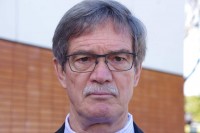Nahan tries to shoot the messengers
Tuesday 25 Oct 2016Treasurer Mike Nahan is currently on a public relations offensive, spruiking his enthusiasm for the privatisation of Western Power.
Dr Nahan regularly points the finger at unions, trying to dismiss our long term opposition to the privatisation of WA’s electricity system as a scare campaign.
But what he can’t dismiss are the facts, and here are a few of them that Dr Nahan has trouble responding to.
South Australian and Victoria are the only states where poles and wires are completely privatised. According to independent reports by Carbon & Energy Markets and St Vincent de Paul, the two states where households pay the most for electricity are South Australia and Victoria. Dr Nahan conceded this point in The West Australian today.
During the 2015/16 financial year, the average household electricity bill in WA was about $1,700. For the same volume of electricity (6,000 kWh per annum), the average bills in South Australia and Victoria, respectively, were $2,300 and $2,100 per annum.
Alarmingly, the Australian Energy Regulator allowed the private owners of Victoria’s poles and wires to pass on $794 million in damages paid to the victims of the 2009 Black Saturday bushfires to consumers through higher prices.
Both the Royal Commission into the bushfires and a coronial inquest into the 173 lives lost concluded that faulty privatised power lines had caused five of the worst blazes.
Having made higher profits for shareholders as a result of underinvesting in the network and preventative maintenance, the private owners of Victoria’s poles and wires were able to offload financial responsibility for their decisions onto the community.
Is this what we want in WA? With our drying climate, you can never fully remove the risk of bushfire, but we shouldn’t knowingly be making things worse by handing over responsibility for the upkeep of our poles and wires to companies where profit is the number one driver.
But we are just as concerned with what is happening now, as we are with what happens after privatisation.
This year, more than 500 positions are being axed at Western Power, as Dr Nahan looks to improve the utility’s bottom line in preparation for sale. This raises further concerns over safety and reliability of supply, given many of these positions are in repairs and maintenance.
There is also a question of what role a privatised Western Power plays in training young West Australians. Between 2012-14, Western Power engaged an average of 54 new apprentices a year. In 2015, only 12 apprentices were put on the books. This year, there have been no new starts.
The Treasurer is also yet to clarify who would pay the $141 million Western Power currently contributes to the Tariff Equalisation Fund each year, which subsidises regional household power bills by almost $3,000 a year.
As unions who employ thousands of electricity workers in WA, we are a significant stakeholder in this debate, and we will do everything in our power to stop privatisation. Dr Nahan knows this, which is why he is trying so hard to undermine us.
His most recent flourish was to label us as hypocritical, because the union movement has some representation (alongside industry and other stakeholders) on the Boards of superannuation funds who have looked to invest in privatised government assets.
Western Power is a highly profitable business that last year delivered a dividend of $401 million to the State Government – money that is used to pay for services like health and education. This level of profitability is why superannuation funds show interest in assets like these, and it’s another reason why Western Power should remain in public hands.
Wayne Wood
Australian Services Union WA Branch Secretary
Les McLaughlan
Electrical Trades Union WA Branch Secretary

